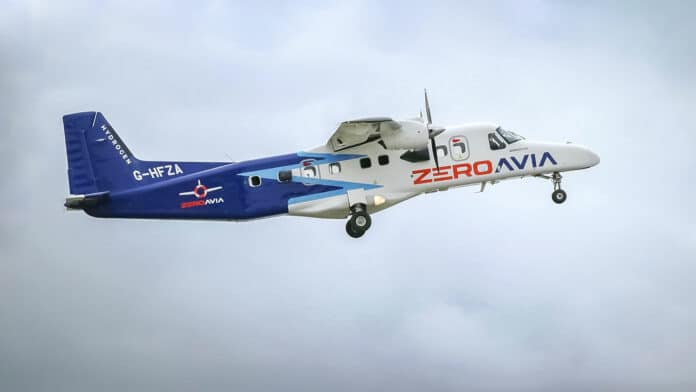The ZA600 hydrogen-electric powertrain could change commercial airline operations forever. Developed by ZeroAvia, the manufacturer of hydrogen fuel cells-powered aviation powertrains, the ZA600 is a 500 to 750 kW continuous hydrogen-electric powertrain for fixed-wing platforms.
Now, the company has announced the completion of its initial prototype ZA600 flight testing campaign using a retrofitted Dornier 228 at Cotswold Airport in the UK. The 10th flight in the initial series was completed last week. The powertrain proved its efficiency and reliability through ten flights in various challenging conditions.
ZeroAvia is working on the Dornier 228, a conventional 19-seater plane that has two propellers, usually powered by kerosene. One of these has been replaced by an electric engine, and the electricity is generated onboard using a hydrogen fuel cell. For the testing period, the other engine remains fuelled by kerosene in case of failure. Once the technology is proven, both engines will run on electricity from the hydrogen fuel cell.
Over the course of the last six months, ZeroAvia says it has sequentially tested different areas of performance following the breakthrough, the first flight of the system in January. During the test flight campaign, the company used a Dornier 228 that was retrofitted with the ZA600.
The retrofitted Dornier reached an altitude of 5,000 feet (1,524 meters) and flew for approximately 20 minutes. In addition, the ZA600 had to operate in the wide temperature range from above-freezing points to 30C (86F) and reach the maximum allowable speed under the Permit to Fly issued by the CAA.
The company says, throughout all phases of testing, the fuel cell power generation and electric propulsion system performed at or above expectations. The ZA600 hydrogen-electric engine matched the performance of the conventional, fossil fuel engine on the opposite wing. In certain tests, the aircraft was able to fly with thrust generated only from the experimental clean propulsion system.
ZeroAvia plans to run commercial flights using an electric engine that creates no carbon emission by 2025, while larger airliners equipped with the ZA2000 won’t be flying earlier than 2027.
ZeroAvia’s Dornier 228 flight testing program is part of the HyFlyer II Project, which is part funded by the UK Government via the Aerospace Technology Institute in conjunction with Innovate UK and the Department for Business and Trade.
